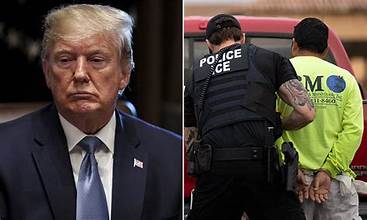What we know about Trump’s mass deportation plans and ICE raids
Here’s what we know so far about ICE enforcement operations in the wake of several immigration-related executive orders Trump signed.
Two days after President Donald Trump signed a raft of executive orders cracking down on immigration, arrests by Immigration and Customs Enforcement officers appear to remain along the lines of “routine operations” and not part of a large scale raid in any one place, a source familiar with operations told NBC News.
Trump’s designated border czar, Tom Homan, told Fox News on Wednesday that ICE had conducted 308 arrests across the country.
For comparison, in September of 2024, the latest month for which data is available, ICE arrested 282 migrants per day.
The source said the arrests targeted criminals, but could not say whether migrants without criminal convictions were arrested as “collateral arrests.”
Related:

Trump Administration Will Allow Migrant Arrests at Churches, Schools
The actions come in the days after officials in major cities friendly to migrants, such as Chicago, Denver and Minneapolis, anticipated ICE major raids of immigrant communities.
The Department of Homeland Security said Tuesday it was ending a policy that restricted Immigration and Customs Enforcement agents’ ability to arrest undocumented people at or near so-called sensitive locations, including houses of worship, schools and hospitals.
NBC News reported last month that the Trump administration would roll back the restriction, which had been in place since the Obama administration. It was continued during the first Trump administration and expanded by the Biden administration to include areas like domestic violence and disaster relief shelters. The restriction discouraged immigration actions from those areas without approval from supervisors in the interest of public safety.
“Criminals will no longer be able to hide in America’s schools and churches to avoid arrest. The Trump Administration will not tie the hands of our brave law enforcement, and instead trusts them to use common sense,” DHS said in a statement announcing the decision Tuesday.
Related:

Trump’s plans if he returns to the White House include deportation raids, tariffs and mass firings
Whether and how that will play out in major sanctuary cities like Chicago is yet to be seen.
“It’s a lot of rhetoric designed to fear and terrorize people, especially immigrants,” said the Rev. Beth Brown of Lincoln Park Presbyterian Church in Chicago. “If they don’t have a signed judicial warrant, they still cannot enter church buildings or faith community buildings, because it’s not just churches — it’s all houses of worship.”
DHS also officially reinstated Migrant Protection Protocols, or what was commonly known as the “Remain in Mexico” policy, which had asylum-seekers wait in Mexico until they were scheduled to appear before immigration judges in the United States.
Mexican Foreign Minister Juan Ramón de la Fuente said the United States made the decision to reinstate Remain in Mexico “unilaterally” and that it was not part of an agreement with Mexico.
Mexican President Claudia Sheinbaum told reporters Tuesday that Mexico has its “own migratory policies” and will engage in future discussions with U.S. agencies about the matter.
Will there be ICE raids?
Trump’s border czar, Tom Homan, told Fox News on Tuesday that there would be “targeted enforcement action,” which is similar to what ICE already does throughout the country every day. NBC News asked Homan how those operations would be different.
“We have more people assigned to the mission,” he said. He declined to say how many people had been assigned.
Related:

As Trump threatens mass deportations, Central America braces for an influx of vulnerable migrants
The Justice Department issued a memo Tuesday with a series of directives instructing Justice Department officials to significantly overhaul its approach to immigration enforcement and prioritize identifying illegal immigrants and prosecuting immigration violations.
The memo orders the FBI, DEA, ATF, the U.S. Marshals and the Bureau of Prisons to “review their files for identifying information and/or biometric data relating to non-citizens located illegally in the United States.”
It also instructs officials to investigate for potential prosecution any state or local officials who resist the enforcement of federal immigration laws, and it directs the Civil Division to examine possible legal action against states or cities with laws barring officials from cooperating with immigration enforcement officers.
There is no precedent for prosecuting state or local officials who are deemed to have resisted federal immigration enforcement.
Where could they be?
While the Trump administration has not said where the first raids will take place, officials familiar with discussions about possible targets say they will be arresting migrants in major metropolitan cities first. Some of the locations under consideration include the Washington, D.C., area, Denver, Los Angeles, Chicago and New York.
What’s next for Trump’s promises of mass deportation?
The Trump administration is sending 1,500 more troops to the southern border, including helicopter crews and intelligence analysts, Acting Secretary of Defense Robert Salesses said in a statement Wednesday.
“This represents a 60 percent increase in active-duty ground forces since President Trump was sworn in Monday,” he said.
Related:
Some immigrants are already leaving the US in ‘self-deportations’ as Trump’s threats loom
Salesses added that the department would be conducting a military airlift to deport more than 5,000 people detained by Customs and Border Protection in San Diego, Calif., and El Paso, Texas.
It is not clear what parts of the government the troops will come from or what their aim will be, according to a defense official and a senior White official.
Trump will most likely have to secure more funding from Congress to make good on his promises for mass deportations. He pledged in his inaugural address to deport “millions and millions” of immigrants back to their home countries. But ICE is already short $230 million to fund its current level of deportations, which removed over 230,000 migrants last year.
In his Day One executive orders, Trump declared a national emergency and ordered the military to help expand detention space and help transport migrants to use Defense Department funding on deportations.
_______
NBC News





